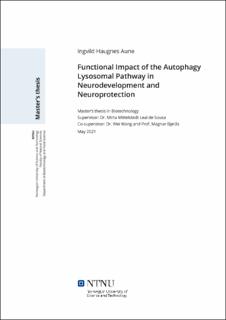| dc.description.abstract | Proteinet ubiquitin C-terminal hydrolase L1 (UCHL1) tilhører en familie av enzymer som hydrolyserer ubiquitin. Enzymet uttrykkes sterkt i hjernen og spesielt i nevroner, men dens primære funksjoner ukjent. Nylig identifiserte Bjørås’ gruppe to mutasjoner i UCHL1-genet hos pasienter som lider av alvorlige nevrologiske egenskaper, inkludert nevrodegenerasjon med optisk atrofi, spastisitetsparaplegi og ataksi. Ettersom den autofagiske lysosomale banen (ALP) er avhengig av ubiquitin, tror vi at UCHL1-dysfunksjon fører til endringer i ubiquitin-prosessering som derved vil påvirke ALP i hjerneceller. I dette prosjektet ble induserte pluripotente stamceller (iPSC) tidligere reprogrammert fra fibroblaster fra pasienter som huser mutasjonene i UCHL1, så vel som friske individer, brukt som utgangspunkt for å generere monolag av neuroner (FB) og hjerneorganoider. Disse 2D- og 3D-neuronale modellene vil bli brukt til å undersøke effekten av UCHL1-dysfunksjon på nevroutvikling og nevrobeskyttelse via potensielle endringer i ALP. Vi viser at iPSCs og nevrale stamceller (NPC) avledet fra friske individer og pasienter som huser UCHL1-mutasjoner, så vel som hjerneorganoider avledet fra sunne individer ble generert og karakterisert basert på morfologiske funksjoner, og uttrykk for spesifikke markører ved qPCR og ICC.
I tillegg viste analyse av autofagisk fluks i NPC ingen dysfunksjon i ALP i pasient- eller sunne kontrollavledede celler, på dette utviklingsstadiet. Foreløpig screening av genekspresjonsnivåer av autofagiske markører i NPC indikerer økt nivå av lysosomalt enzym Cathepsin D i pasientavledet NPC, noe som tyder på potensiell oppregulering av lysosomal funksjon i disse cellene. Disse dataene må imidlertid bekreftes med flere biologiske replikater og på proteinnivå. Vanskeligheter med å dyrke og differensiere NPC, den mellomliggende tilstanden i monolagsprotokollen, hindret ytterligere differensiering til FB-neuroner og utførelse av funksjonelle analyser. Flere forsøk og forskjellige protokoller ble brukt for å overvinne denne begrensningen, men uten å lykkes. Også vanskeligheter med å generere pasient-avledede hjerneorganoider stoppet analysen av potensielle endringer i hjernens utvikling på grunn av UCHL1-mutasjoner. Våre foreløpige data antyder at hvis UCHL1-mutasjoner endrer ALP-funksjonen, kan disse effektene være mer fremtredende på senere utviklingsstadier, for eksempel ved FB eller modne motorneuroner. Til slutt kreves det videre arbeid med utvikling av mer pålitelige og robuste protokoller for generering av NPC, FB-neuroner og hjerneorganoider. | |
| dc.description.abstract | Mutations in the ubiquitin C-terminal hydrolase L1 (UCHL1) protein are implicated in human disease, including neurodegenerative disorders. This enzyme is highly expressed in brain, especially in neurons. Although it belongs to a family of enzymes that hydrolyzes ubiquitin, its primary functions are unknown (1). Recently, Bjørås’s group identified two mutations in the UCHL1 gene in patients suffering from severe neurological features, including early-onset neurodegeneration with optic atrophy, spasticity paraplegia and ataxia (1). As the autophagy lysosomal pathway (ALP) is dependent on ubiquitin, we hypothesized that UCHL1 dysfunction leads to alterations in ubiquitin processing which would thereby affect the ALP in brain cells (2). In this project, induced pluripotent stem cells (iPSC) derived from fibroblasts of patients harboring mutations in UCHL1, as well as healthy individuals, were used as starting point to generate monolayer forebrain neurons (FB) and cerebral organoids. These 2D and 3D neuronal models were used to investigate the impact of UCHL1 dysfunction on neurodevelopment and neuroprotection via potential alterations in the ALP. We show that iPSCs and neural progenitor cells (NPC) derived from healthy individuals and patients harboring UCHL1 mutations, as well as cerebral organoids derived from healthy individuals were successfully generated and characterized based on morphological features, and expression of specific markers by qPCR and ICC. In addition, analysis of autophagic flux in NPC revealed no dysfunction in ALP in patient- or healthy control-derived cells, at this developmental stage. Preliminary screening of gene expression levels of autophagic markers indicated increased levels of the lysosomal enzyme Cathepsin D in patients-derived NPC, suggesting potential up-regulation of lysosomal function in these cells. This data, however, must be confirmed with several biological replicates and at protein level. Limitations in culturing and differentiating NPC, the intermediate state in the monolayer protocol, hindered further differentiation to FB neurons and the execution of functional assays. Several attempts and different protocols were employed to overcome this difficulty, however, without success. Also, generation of patient-derived cerebral organoids was not feasible and could potentially be a consequence of abnormal neural development due to UCHL1 mutations. Our preliminary data suggest that, if UCHL1 mutations alters ALP function, these effects may be more prominent at later developmental stages, such as at FB or mature motor neurons. Finally, further work is required on the development of more reliable and robust protocols for the generation of NPCs, FB neurons and cerebral organoids. | |
